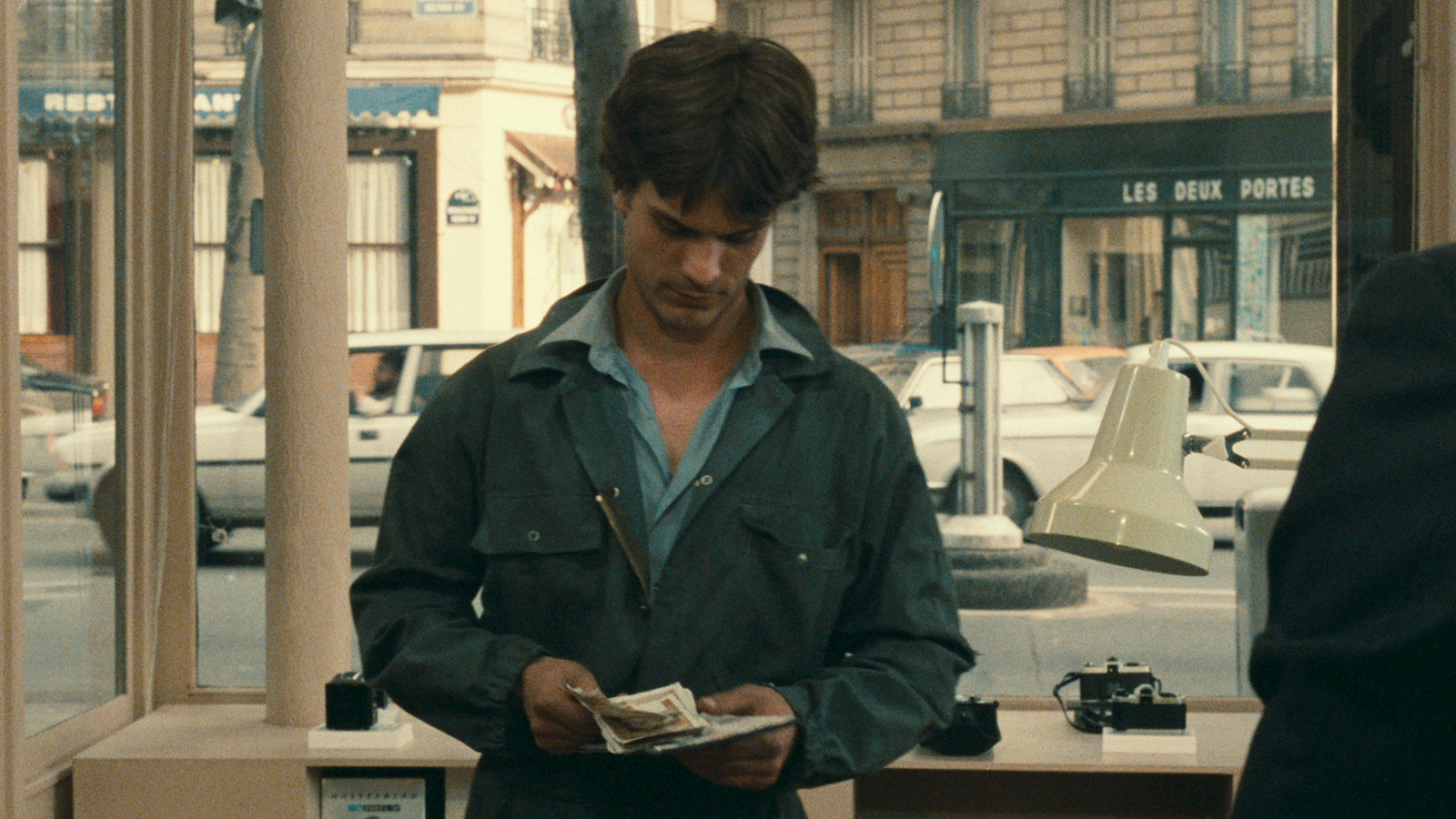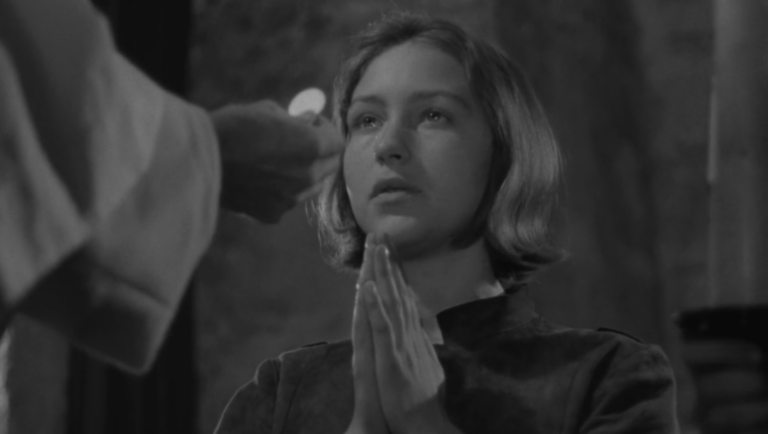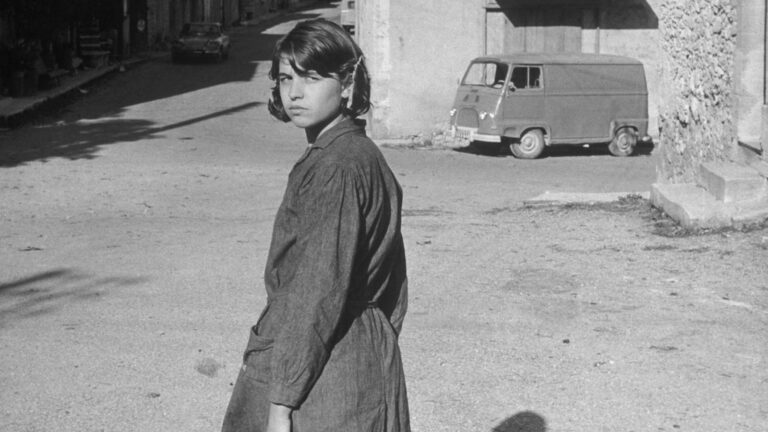At Cannes, Bresson was quite rankled about the organizers playing an extremely well-made film, albeit tonally different film before his L’Argent. No chef would serve a chili-garnished appetizer that derails your tasting experience of the plat principal, would they? Unfortunately, at the BFI, some seated members were affronted that Lloyds Bank, with its cheesy music and dark stallions, would reassure us that they ‘are always by our side’ through the final advert. To express the patent discontent, it was promptly followed by cries of ‘rubbish’. But it didn’t scamper my viewing experience of L’Argent, because from the moment the stallions were serenaded to the horizons by the man in pain, the auditorium was robbed of all chatter, both on and off the screen. Bresson may have joked to the reporters that the more films he made, the more he felt he could only operate with sounds; the human voice is the most majestic of sounds to him, and like a man worthy of his prudence, he uses it the least.
There was a reason I chose to single out L’Argent for expounding this theory of Bresson’s cinema vs cinematograph. L’Argent is more unadulterated by any of theatre’s filaments and its Bresson’s finest filigree of a reactive automatism that underpins all his works. In some, its undercurrent is less unyielding than it is in others, but one can never fail to recognize it. In the eyes of Fontaine, Michel, Targe, Marie, and Mouchette, the circumstances speak more reactively than through a proactive expression on the part of the actor. With Targe, one could say that Bresson has robbed all expression and made his appearance aseptic, yet Targe’s rigidity isn’t to say that he is a product of unfortunate events. Targe reacts to or rather communicates with the world in the wrong sense – not like Fontaine from A Man Escaped. His instinctive reaction to his surroundings is to take and not lose, whereas Fontaine’s is to weigh, exercise caution, but ultimately give in to his better angels. In the grand theater of Cinema, some choose to focus on the visual, the structure, or the element of time. Bresson is much more innate – he beams his fastidiousness onto the reactiveness of his untrained and defenseless cast. The result is a cinema that is so forceful without the intention to ever be so. This is perhaps the difference between le cinéma et le cinématographe that Bresson emphasizes when he says he wishes people to feel about a film before they can let their intellects fidget with it. It’s a very Krishnamurti-esque take on the purposes of the medium; the audience is meant to sense the film before thought claws through with a pressing need to regiment what one has just seen. The camera exists without the director intervening to poke out a specific reaction from a trained actor. It exists for an uninitiated human to lend his or her reaction to an utterance or a circumstance.
In such uncharted waters, one can never be sure that one achieves what one intends and Bresson is always quick to prefix his statements with the fact that he is only trying in that direction. But, with the years behind him, he pieces together a relationship between sight and sound that is far more than an effort. Unlike the brash and uninvited medley of modern sounds that weasel into his Au Hasard Balthazar, the sounds of L’Argent capture only what the modern world has to offer without the foil of pastoral life – scooters, spanners, and a slew of incomprehensible chatter. When the sounds travel alongside Targe, he is aloof and tight-lipped. When the noises cease to exist, we ascertain that Bresson primes us and Targe to react. Sight and sound are in constant motion, only for one to relent where the other needs exposition. If I were to borrow a crude analogy – although one that precisely reflects how I felt during the film – is that of a pinched nerve. It’s almost as if a curious surgeon presses down on a nerve to observe the invigorated gush of blood before releasing it to ease the flow. The only difference is that the surgeon is a filmmaker and the vein of blood is our ineluctable stream of being.
Ironically, though the film is adapted from Tolstoy’s The Forged Coupon, there are no traces of Tolstoy. Bresson circles his film around the first part of the novel which shows misdeeds as the catalyst and omits the second part which exists to turn counter-clockwise on the previous cycle. The result is a film that is bleak – which is quintessentially Bresson with the sole exception of A Man Escaped – and far from Tolstoy’s vehement pursuit of truth in God’s charity. From the first interchange of the forged banknote, every hand that holds it washes it off at the expense of another. Targe is the only one who is unsuspecting of the note in his hands and does nothing to retaliate when questioning his wrongdoers; there is no indignation, no heated skirmish, merely a resignation to the toxic dishonesty of this new world. The store assistant even punctuates this when he innocently questions his boss – “I thought dishonest people understood each other?”
Perhaps the only remaining fractal of compassion is through the unquestioned charity of Targe’s hostess. Her relentless toil for her family, her unwavering faith, and her unspoken compassion reminds me of Sofya Semyonovna from Dostoevsky’s Crime and Punishment or even Liza from his Notes from the Underground. She is invested in the tranquility of her home and all of whom it shields, regardless of their origins. But her intransigent yet removed solicitude doesn’t communicate itself to Targe, and it may indicate he conflates intimacy with warmth and good intentions. Here is a man who has been repeatedly misunderstood by the world and as a consequence, he misunderstands those around him. He becomes vile, but it’s conflicted vileness; though he murders the hoteliers, he is unsure of what he is to do with his hostess. He tails her around her house, unable to understand why she isn’t in a transactional relationship with the world. It culminates in her murder and as he raises his axe, his gruff voice demands – “Where is the money?” – indicating that he has learned to communicate in the way the world has taught him.
Even more definitive is the interaction between conscious and unconscious guilt. The parallel narratives of Lucien and Targe only bore deeper into this zero-sum game. The only division between them is their perception of what constitutes guilt; for Targe, guilt exists in the smallest of intentions and for Lucien, it only exists in bodily harm. One needs to murder, he says, to have the other on his conscience. Lucien believes he can pilfer from the world as long as the equilibrium is maintained. For him, the dissonance caused for his victim is only monetary and he sees no harm in fomenting it. After all, the man walks away with his life and Lucien’s conscience is left unscathed. Both men communicate with their world, but the question here isn’t about right or wrong; it’s about effectiveness against ineffectiveness. Lucien is effective in manipulating the order of the world while Targe isn’t. The question of right or wrong is then placed between the rules governing this narrative; society has its fair share of wrongs, but is Targe entirely inculpable for perpetuating it when he had the chance to change through his hostess’s distanced embrace?
I often find it difficult to vocalize a viewing of Bresson because of how different the construct of his films is. They aren’t palate-pleasers and certainly not stories of redemption. You become one with his camera and observe his characters act and react, often without sufficient motivation. You are left to divine why a character speaks one way but acts in another. It would be inappropriate to say that he effaces the human component of films. We are just as much contradictory in our comportment as we are expressive and Bresson’s cinema is the rare horse that chooses to rebel against the latter. For showing me this, I shall always remain thankful to him.





